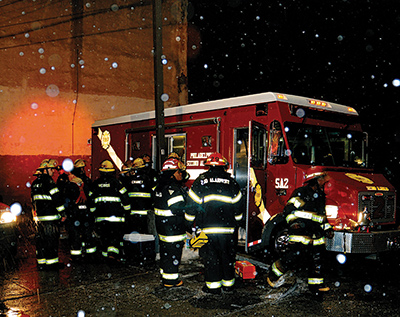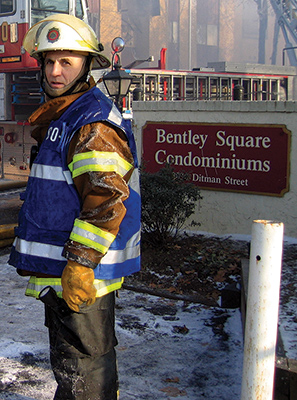
By WILLIAM SHOULDIS
View Image Gallery>>
The challenge of today’s integrated emergency services requires a fire officer to have in-depth knowledge of lines of authority and resource capabilities. Having the skills to stabilize the situation and not be part of the problem needs a preparedness plan. Fire officers, training chiefs, and company commanders must have a process for predicting strategic steps to perfect proficiency based on incident activities.
The standardized national incident command system (ICS) was developed to be a management “job aid” for planning and response. Regardless of the circumstances, ICS is deeply rooted in decades of all-hazard best practices. Better service and safety are the measuring sticks for any agency. A realistic goal of training officers is to create a workable template to guard against operational oversights when the alarm bell is activated. Professional development programs for the incident commander (IC) position must include an understanding of mutual-aid assistance agreements, occupant behavior, building construction, fire growth, ventilation, and estimating firefighters’ physical limitations. Many times the demands of command post leadership force split-second decisions that have no margin for guessing.
 |
| (1) Sharing information and providing logistical needs are essential elements in a department improvement plan. Having a support apparatus for timely exchange of input and ideas is vital for a meaningful after-action report. (Photos by Greg Masi.) |
What We’ve Learned is a book by William C. Richmond, a former chief in the Philadelphia (PA) Fire Department and a mentor to many field commanders. His repeated theme is that ICs have many choices. Most choices are selected on a rational judgment dictated by standard operating guidelines (SOGs), emergency operating plans (EOPs), or agency procedures but some can be emotionally driven. Concrete benchmarks provide a framework for decision making at the emergency incident. The sole purpose of command is to coordinate all activities, and it is a misconception that a fire department can always initiate an aggressive attack. In reality, an offensive mode is not an obligation-merely an option based on the scope, situation, and staffing. The position for an IC during an investigation, initial fast attack, or immediate request for additional alarms requires training and experience.
Mobile and stationary positions have advantages and disadvantages. Quickly, command must correctly evaluate the strategy, tactics, and resources needed. An awareness of the complexities of an incident, from dispatch to demobilization, requires an emphasis on maintaining a comprehensive perspective of changing conditions. Progress reports from each geographical area or functional assignment are critical. Certainly, modern materials such as synthetic furnishings, lightweight construction features, and the limitations of protective clothing beg for the IC to take a cautious approach before giving directions. For individuals to be confident and comfortable in making command decisions, there needs to be an operational outline with firm policies, workable procedures, meaningful training, and a credible method for the selection of supervisors.
Despite the size of a community, the emergency response can vary from firefighting to prehospital medical care to hazmat to vehicle extrication to confined space entrapment and even wilderness search. The IC must focus on a simple and straightforward management plan: stop the crisis; allocate resources; track the tasks; and, finally, have all first responders return to their families at the conclusion of a call.
View Image Gallery>>
Handling a “no-notice” event is a fire department’s organizational objective. It is supported by a long history and the deep traditions of the fire service; yet, today’s fire departments are under siege because of reduced budgets and a lack of large-scale multiagency deployments. Unfortunately, without the benefit of regular interagency training or seasoned field commanders, there can be cascading consequences in communities where public safety agencies do not work together. The results are less control and more confusion. Commanders must have a full understanding of the capabilities of public, private, and nongovernmental entities.
Recently, three very diverse and difficult events made national headlines. The commonalities of compressed time, incomplete information, high-risk assignments, emergency communication, and interagency cooperation were factors each IC faced.
 |
| (2) Clear communication and identified organizational positions require reflective vests with titles during a rapidly advancing fire. |
The first was a structure fire in an apartment building in the “Back Bay” section of Boston, Massachusetts. The second involved train derailments with a crude oil fire near Lynchburg, Virginia, and the Kanawha River by Mount Carbon, West Virginia. They became high-profile incidents because of the loss of lives, the loss of property, and environmental contamination. The third occurred in early July 2014 in a residential Philadelphia neighborhood when a fast-moving rowhouse fire devastated eight homes, killed four children, displaced 42 residents, incited angry protesters, and resulted in a community meeting to stop rumors and innuendos. All three incidents drew the attention of instructors and teaching topics relating to “whole community” preparedness.
Fireground Decision Making Characteristics
The situations required a rapid, realistic action plan. Response readiness under extremely adverse conditions requires a mental model for ICs to identify needs and match capabilities. Consider having a user-friendly checklist to assist in any fireground analysis. Unfortunately, there are far too many tragic stories that ignore the fact that the IC is the gatekeeper for five critical components of effective operational management.
Information Collection and Sharing
A significant challenge for ICs is to stay ahead of changing conditions. Faulty perception or an inability to predict problems will interfere with real-world tactical thinking. A comprehensive risk assessment is a critical component in the development of an initial action plan. The IC or an appointed safety officer must manage the inherent risk and identify the hazards at the emergency event. The IC’s awareness of size-up factors such as apparatus placement, access/egress paths, water supply, staffing levels, and careful monitoring of the passage of operating time is vital to a safe outcome. It is impossible to consistently coordinate resource deployment without a reliable means to manage the flow of information.
View Image Gallery>>
Incident Choices
Incident choices are directly proportionate to the risk and reward ratio. The firefighting attitude on substantial risk-based rules is clear: Do not take significant risk under most circumstances, consider an acceptable level of reasonable risk when calculating modes of operation, and avoid needless risk taking when lives or property is not savable. Providing an injury-free work environment hinges on the IC’s ability to anticipate fire behavior and collapse potential. Both depend on training and experience. Often, the IC can use a quick-start guide to help prepare the plan. Command tools commonly found at the incident command post are status boards for a visual display of the organizational structure and situation, a portable radio to obtain verbal input from subordinates, and following the widely adopted principles of “LCES”-lookouts, communications, escape routes, and safety zones. Certainly the application rate of hose streams, nozzle reach, crew size, and the supply of breathable air are considerations in the offensive mode while minimum distance in the establishment of a collapse zone and choosing exterior water streams are considerations in a defensive mode. Knowing the location of companies and crews is an essential element in operational management.
Scene Control
Understanding strategy, tactics, and the communication plan allows an IC to adapt to dynamic conditions. During the initial phase, it is not unusual for division and group supervisors to encounter insufficient staffing to safely complete some basic fireground tasks such as stretching a kink-free hoseline, raising portable ladders, and conducting a primary search. ICs can achieve control by updating a command board to track tasks, secure the perimeter, monitor traffic flow, and identify specific locations of working members. Frequently, the duration of a response will require relief. Regardless of the type of deployment, accurate accountability is mandated. Underestimating the need for planning and logistical support will result in an inability to coordinate the scene.
Resource Allocation
Quality company inspections and preincident planning will greatly assist the IC in determining operational priorities of life safety, stabilization, and property/environmental conservation. Time and trigger points such as location and extent of the problem, fire load, stopping the fire spread, portable ladder placement, evacuating occupants, utility control, dangers during overhaul, usage of built-in fire protection features, and structural integrity are concerns when creating suppression, ventilation, and search teams. Do not overlook the need for additional personnel for rapid intervention, safety, interviewing witnesses, monitoring roadways, and responder rehab when making assignments. You can use mobile handlines vs. stationary master streams to extinguish flames or defend exposures. Equipment and expertise are requirements in dividing scarce resources.
View Image Gallery>>
Reputation Preservation
The ability to transfer messages between the IC and key positions is critical. The command and general staff need to be briefed on important fireground changes. Communication must take place between the various layers in the workforce on assignments, assessing probability of occupant survival, emergency evacuation protocols, designating rally points, and implementing incident command positions-all while keeping the public informed on evacuation zones, traffic routes, first-aid stations, and shelter locations to increase the confidence of the community in the fire service’s ability to mitigate the threat. Preparing prevention messages such as installing smoke alarms, carbon monoxide detectors, encouraging emergency escape routes with predetermined gathering points, working with public safety partners on senior citizen home assessments, and having fire department representatives at public meetings are all meaningful methods to address reputation management.
Ensuring peak performance from the command position requires a connection between communication, delegation, and enforcement of operating procedures. Preparedness is the cornerstone. Have a practical plan to address the essential elements of information, incident, scene, resource, and reputation management. Today’s ICs must learn from the administrative and operational mistakes of past generations. The IC is accountable for first responders’ health and wellness. Ultimately, command is responsible for gathering input, setting priorities, and coordinating resources. Having compassion for those suffering a loss and providing care for first responders with an adequate work/rest cycle are paramount. Training with a fast, firm, fundamental fireground formula for command decision making will increase the odds of a positive outcome.
As the all-hazards fire service continues to change, so does the importance of identifying the critical components of command. When minutes matter most, you will need an operational management plan to avoid the combustible mixture of confusion and conflicts. The IC will be the compass and conscience for appropriate actions.
View Image Gallery>>
WILLIAM SHOULDIS served in line and staff positions with the Philadelphia (PA) Fire Department for 35 years, retiring as a deputy chief. He is an instructor at the National Emergency Training Center and a guest speaker at the Graduate School at St. Joseph’s University.
Related Links
Incident Commander Checklist: A Quick Reference Guide
Fireground Accountability: Where Are We Failing?
To request information go to fireeng.hotims.com
Fire Engineering Archives

